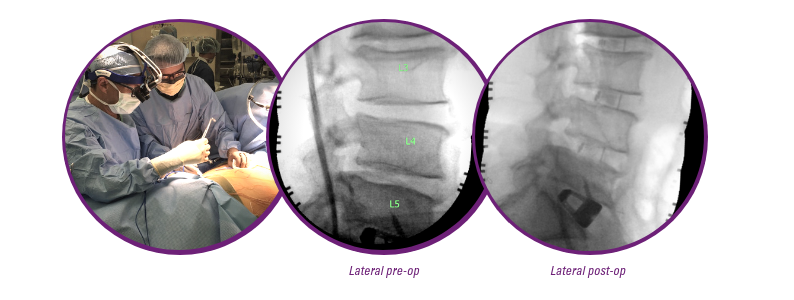![]()
In our Featured Case series, NuVasive® will showcase innovative cases and how our unique technology is integrated to create a cohesive system to address key patient pathologies. Our mission at NuVasive is to change patient lives and we are constantly focused on how to deliver improved patient outcomes, increase OR safety and efficiency, and extend our technology to future applications.
In this Featured Case, we present a 52 year old male with spinal stenosis from L1-2 to L5-S1. The patient had tried medicine, physical therapy, chiropractor appointments, and steroid injections before consulting with Dr. Clark. The surgical plan was based on the patient’s pathology and 24 degree PI-LL mismatch. In stage one, Dr. Clark performed a lateral interbody fusion. A Lateral ALIF™ was done at L5-S1, with the use of BASE. Following that, Dr. Clark performed an L1-5 XLIF® utilizing 15-degree cages at each level. In stage two of the patient’s surgery, Dr. Clark used a percutaneous screw fixation from L1 to the pelvis. He used Reline MAS reduction screws and utilized both Bendini and iGA technologies to ensure correction of the PI-LL mismatch.

The procedure was done with LessRay technology in the OR.
“LessRay definitely made an impact on radiation exposure. The room staff was surprised we had cut radiation by up to 80% in some shots, yet still able to maintain great imaging,” says Dr. Clark
Dr. Clark used a variety of LessRay features to help reduce the number of shots and radiation emitted throughout the case. LessRay allowed Dr. Clark to track back to the targeted anatomical location and visualize the patient’s correction in real time.
“The LessRay tracking is a nice touch, assisting our techs in locating the spine when they’re coming in and out for shots. This in turn helped cut down on unnecessary shots of fluoro, surgical time, and anesthesia time” says Dr. Clark
The total radiation amount was 128.32 milligrays. The total time in the OR was 6.5 hours for both stages.
The patient was discharged to go home only six days after surgery. He is doing well with no leg pain and visits physical therapy for recovery.
Click here to read more featured cases.
